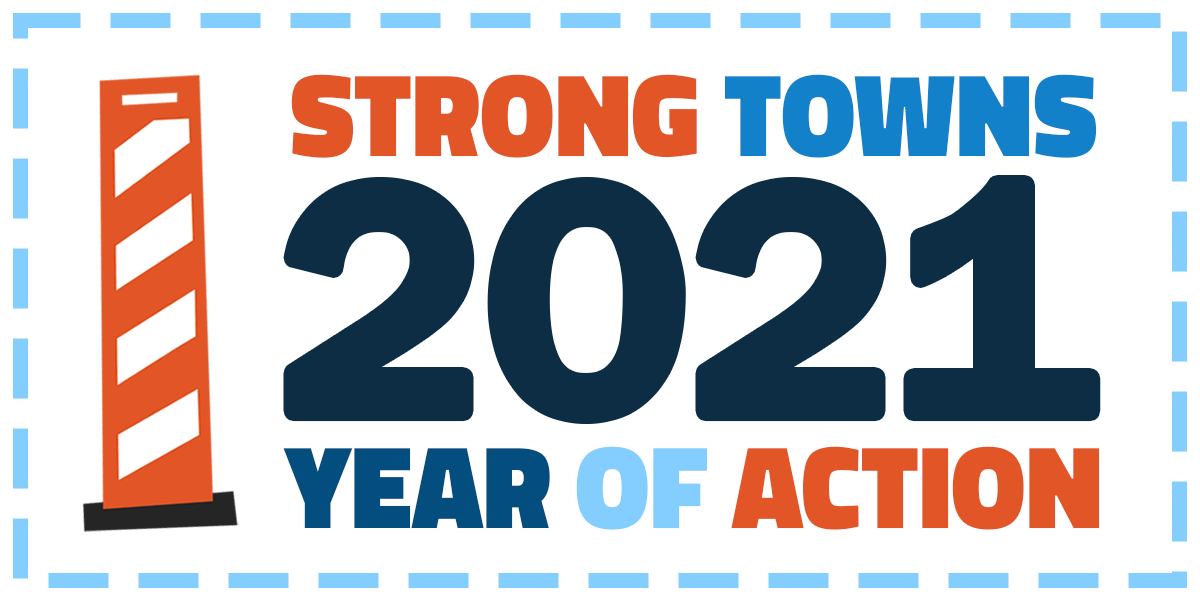Friday Faves - Your Weekly Strong Towns Roundup
Next week is our Fall Member Drive, and we’re gearing up to deliver a ton of content celebrating our members and everything they do to support the Strong Towns movement. Without them, what we do wouldn’t be possible—members are the real MVPs!
One (small) way in which we’re giving thanks to our members this year is with the Strong Towns 2021 Member sticker:
This one's exclusively available to people who are members this year (and we'll have a new sticker next year). Put it on a laptop, notebook, or water bottle, and show the world that you're a part of the Strong Towns movement.
If you'd like to claim your sticker, just make sure that your membership is active, and we’ll be in touch with you via email to get your sticker mailed out to the right place. Thanks!
Comment of the Week:
This comment came from the article “The Infrastructure Bill Has Passed. What Now?” Check it out here to join in on the discussion!
Here’s what Strong Towns staff were up to this week:
(Source: Oh, MG.)
Daniel: Pop social-scientist Malcolm Gladwell has always both interested and frustrated me. His millions of books sold are a testament to his ability to weave a good story out of a pattern of facts, but sometimes the story takes precedence over the complex nuance of reality. I have similarly conflicted feelings about this blog post of his, “The Housing Problem Doesn’t Care About Your Feelings.” What Gladwell gets absolutely right: Policy problems are complex, and there’s an urgent need in a field like housing and homelessness policy to be clear-eyed about the actual empirical results of the policies we choose, instead of appealing to moral sentiment and doing the things that feel most just, or feel like they should help. Where Gladwell missteps is in implying that smarter experts, armed with better data, are going to be able to settle these debates and definitively answer these empirical questions about what helps. I think we’ve seen enough from the economics profession to know that isn’t true, and that implies a different mindset: fewer grand experiments, more iterative small bets. Regardless of what we think we do or don’t know.
(Source: Unsplash.)
Michelle: I am entering into a hectic season with the business that the holiday season brings for my family and my big caseload of event planning tasks at work. I’m grateful to be busy, but it can still be overwhelming. The latest article from Zen Habits is just what I needed to get into the right frame of mind for it all.
(Source: Unsplash.)
John: We’ve written a lot at Strong Towns about the devastation wrought by urban freeways. The heyday of inner-city freeway-building was the 1950s and 1960s, during which whole blocks were razed, many people displaced, and many neighborhoods trapped in a cycle of poverty, disinvestment, and neglect. But, as this Los Angeles Times article describes, the U.S. still hasn’t fully learned its lesson. At least 200,000 people have lost their homes to federal road projects over the last three decades. (“The actual total is higher because many states fail to report how many homes are taken annually.”) And as before, many of the folks losing their homes are people of color living in poorer neighborhoods. There are freeway projects being considered right now in Louisiana, South Carolina, Texas, and Oregon, among other states. We may have exchanged one euphemism—”urban renewal”—for others (“expansion,” “improvement,” etc.), but the results will, tragically, be the same.
(Source: Unsplash.)
Rachel: Local farming and homegrown food are big passions of mine that I’m finally getting to exercise more after buying my first home this past May, and finally having a small yard to plant in. Last weekend, I put the vegetable patch to bed for the winter, a chance to reflect on and appreciate the amazing opportunity to grow a little of my own food (and dream of a bigger patch next summer). This article in the Solutions Journalism Exchange spotlights a program in Detroit that is helping others to access land ownership so they can grow food. It’s called the Detroit Black Farmer Land Fund. One staggering statistic from the article is that, “In the 1910s, Black farmers made up 15 percent of all farmers, compared to less than one percent today.” This new program aims to help turn that around, something particularly doable and meaningful in a city with lots of vacant land. Turning empty lots into small-scale farms and allowing families to build household wealth through land ownership in the process… That’s certainly a Strong Towns approach.
—
Finally, from all of us, a warm welcome to the newest members of the Strong Towns movement: Lee Arevian, Glenn Barr, Jorge Benitez, Jon Boyd, Vincent Bray, Bruce Cotting, Paula Coughlin, John A Duvall, Anne Fairfax, Bryan Graveline, Mark Haubner, Candice Innabi vazquez, Shaun Lee, Robert Long, Sharon Mandair, Brock Parkin, Beth Rankin, Dianne Russell, Katy Shackelford, AJ Singh, Court Skinner, and David Wharton.
Your support helps us provide tools, resources, and community to people who are building strong towns across the country.
What stories got you thinking this week? Please share them in the comments!






